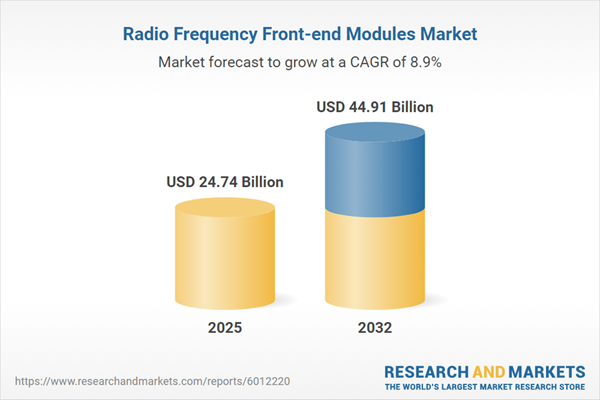Speak directly to the analyst to clarify any post sales queries you may have.
As wireless connectivity becomes mission-critical, senior leaders are evaluating advanced radio frequency front-end modules to futureproof enterprise networks and maintain operational agility. The need for reliable infrastructure and strategic investment is intensifying across industries adapting to new digital demands.
Market Snapshot: Radio Frequency Front-End Modules Market
The radio frequency front-end modules market is currently valued at USD 22.71 billion, forecast to reach USD 24.74 billion by 2025 and USD 44.91 billion by 2032, achieving an 8.89% CAGR. This growth is driven by widespread 5G rollout and mounting enterprise expectations for uninterrupted, secure wireless access. New technical benchmarks and infrastructure modernization are accelerating demand, with advanced front-end modules being core to evolving enterprise wireless networks. Intensive device adoption across business sectors, alongside the constant refinement of connectivity standards, reinforces the strategic role of these modules in building scalable and resilient systems.
Scope & Segmentation in the Radio Frequency Front-End Modules Market
This research delivers targeted segmentation for procurement, technology alignment, and investment planning in the radio frequency front-end modules market. Decision-makers can benchmark supplier capabilities and guide purchasing strategy at both global and regional levels.
- Module Type: Combiners, surface acoustic wave filters, bulk acoustic wave filters, low noise amplifiers, integrated power amplifiers, discrete power amplifiers, and signal switch architectures. Each variant is engineered for optimized connectivity and signal fidelity within enterprise-grade wireless deployments.
- Frequency Band: Sub-3 GHz, 3–6 GHz, and millimeter-wave options serve performance goals such as latency reduction, higher throughput, and broad network scaling, ensuring suitability across diverse industry requirements.
- Application: Modules enable wireless integration in aerospace, defense, automotive, network infrastructure, customer premises equipment, and a broad spectrum of industrial and consumer endpoints, each imposing different demands on compliance, ruggedness, and reliability.
- Material: Gallium arsenide, gallium nitride, and silicon present tailored solutions balancing efficiency, resilience, and adaptability for use cases from mobile networks to critical infrastructure.
- Distribution Channel: Direct sales, collaboration with electronic manufacturing service providers, original equipment manufacturer partnerships, and integration-centric approaches support efficient procurement and responsive supply operations.
- Region: The Americas, EMEA, and Asia-Pacific are characterized by unique adoption drivers, compliance frameworks, and partnership landscapes, each presenting discrete opportunities and challenges for market entry and expansion.
- Key Companies: Qorvo, Skyworks Solutions, Broadcom, Murata Manufacturing, TDK Corporation, Qualcomm, NXP Semiconductors, Infineon Technologies, STMicroelectronics, and Analog Devices deliver comprehensive portfolios aligned with enterprise connectivity objectives.
Key Takeaways for Senior Decision-Makers
- Vendors are broadening product features to support evolving deployment environments and enabling future scalability as wireless standards mature.
- Custom engineering supports demanding sectors, such as integration of advanced radar for automotive and mission-compliant communications for aerospace and defense.
- Locally adapted operating models help enterprises respond to complex regulatory shifts and ease regional adoption barriers.
- Strategic partnerships, rapid product cycles, and tailored supplier relationships enhance enterprise agility when customer or industry needs shift.
- Collaboration with electronic manufacturing service providers builds resilient supply chains that can accommodate disruptions and regulatory variations.
Tariff Impact and Supply Chain Strategies
New U.S. semiconductor tariffs have led enterprises to reassess sourcing, diversify supplier bases, and explore nearshore and value engineering alternatives. Corporate strategies now emphasize proactive inventory buffers and detailed risk analysis, aiming to secure supply continuity and limit exposure in complex global trade environments. Implementing responsive supply frameworks allows organizations to better absorb regulatory and market shifts, strengthening resilience across procurement cycles.
Research Methodology & Data Sources
This analysis is based on secondary research, targeted stakeholder interviews, and direct discussions with procurement, engineering, and strategy experts. Data is cross-validated with recent technology trends and policy developments to provide an up-to-date overview of the radio frequency front-end modules industry.
Why This Report Matters
- Senior leaders can act decisively on investment, design optimization, and regulatory risk in wireless infrastructure projects.
- Segmented market and regional insights help organizations allocate resources and plan adoption strategies efficiently.
- Forward-looking frameworks enhance the ability to monitor technology and supply chain evolution, strengthening organizational resilience and market positioning.
Conclusion
This report gives leadership teams clarity to drive informed decisions, adapt to changing regulatory landscapes, and support sustained success in the wireless technology market.
Additional Product Information:
- Purchase of this report includes 1 year online access with quarterly updates.
- This report can be updated on request. Please contact our Customer Experience team using the Ask a Question widget on our website.
Table of Contents
3. Executive Summary
4. Market Overview
7. Cumulative Impact of Artificial Intelligence 2025
Companies Mentioned
The companies profiled in this Radio Frequency Front-end Modules market report include:- Qorvo, Inc.
- Skyworks Solutions, Inc.
- Broadcom Inc.
- Murata Manufacturing Co., Ltd.
- TDK Corporation
- Qualcomm Incorporated
- NXP Semiconductors N.V.
- Infineon Technologies AG
- STMicroelectronics N.V.
- Analog Devices, Inc.
Table Information
| Report Attribute | Details |
|---|---|
| No. of Pages | 193 |
| Published | October 2025 |
| Forecast Period | 2025 - 2032 |
| Estimated Market Value ( USD | $ 24.74 Billion |
| Forecasted Market Value ( USD | $ 44.91 Billion |
| Compound Annual Growth Rate | 8.8% |
| Regions Covered | Global |
| No. of Companies Mentioned | 11 |









